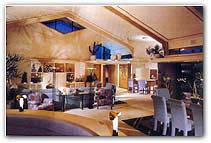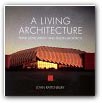
|
Simplicity and Repose
excerpted from the book Copies of this book can be obtained by clicking on the title above, or the book cover at the bottom of the page.
To know what to leave out and what to put in; just where and how, that is to have been educated in the knowledge of simplicity.
The qualities of simplicity and serenity are evident everywhere in nature. Wright made a clear distinction between elimination and simplicity: "Five lines where three are enough is always stupidity. Nine pounds where three are sufficient is obesity. But to eliminate expressive words in speaking or writing, words that intensify or vivify meaning, is not simplicity. Nor is elimination in architecture simplicity. It may be, and usually is, stupidity." Nothing better exemplifies true simplicity than the ancient woodblock print of Japan. In Japanese prints we find that the supreme principle of aesthetics is elimination of the insignificant, discovery of the essence. This process is true simplification, achieving a clean work of art where nothing can be added, nothing subtracted, without detriment to the whole. Wright discussed simplicity in his autobiography: "Organic simplicity might everywhere be seen producing significant character in nature. I was more than familiar with it on the farm. All around me I might see beauty in growing things and, by a little painstaking effort, learn how they grew to be beautiful. None was ever insignificant. Only as a feature or any part becomes a harmonious element in the harmonious whole does it arrive at the state of simplicity. "But simplicity is not in itself an end nor is it a matter of the side of a barn but rather an entity with a graceful beauty in its integrity from which discord, and all that is meaningless, has been eliminated. A wild flower is truly simple. An excessive love of detail has ruined more fine things from the standpoint of fine art or fine living than any one human shortcoming—it is hopelessly vulgar. Too many houses, when they are not little stage settings or scene paintings, are mere notion stores, bazaars, or junk-shops. Decoration is dangerous unless you understand it thoroughly and are satisfied that it means something good in the scheme as a whole; for the present, you are usually better off without it. Merely that it 'looks rich' is no justification for the use of ornament. Simplicity is a consequence, never a cause." "Repose is a quality of architecture essential to harmony with nature and humanity. When man wants to rest, he puts his body in a position where he no longer has to exert effort to resist gravitational force. He is then in a state of repose, a natural condition if he is not in motion. The landscape has this sense of tranquillity. Simplicity and repose give architecture grace and concord." "Build buildings that you feel when you come into them, that have repose. You want a sense of human dignity and worth in what you feel as you live in them, and what they do to you because buildings must be experienced. You can't listen to them as you would music and you can't look at them the way you do a painting. Simplicity and repose are qualities that measure the true value of any work of art." The concept of repose in a building is essential as it responds to the ever-present force of gravity, but it does not deny the need for dynamic space. In an organic building, dynamic forms and space still recognize the force of gravity. The Guggenheim Museum in New York City is an example of a dynamic, exciting space that still has repose. The spiral ramp that expands outward as it rises is a powerful statement of motion. The simplicity of the design, the mono-material, vertical fins, and the harmony of its curved shapes create a sense of stability and rest. The horizontal line is the line of tranquillity. It is the line that gravity gives to water, the line of the prairie, the line that we humans take at rest. A building relates to the flat plane of the land through an expression of horizontality. Roofs that have generous overhanging eaves with flat soffit planes will relate the structure to the earth, providing a sense of shelter and repose. We no longer live in simple terms, in simple times or places. Life is a more complex struggle now. It is now valiant to be simple; a courageous thing even to want to be simple. It is a spiritual thing to comprehend what simplicity means. -Frank Lloyd Wright
|
|

